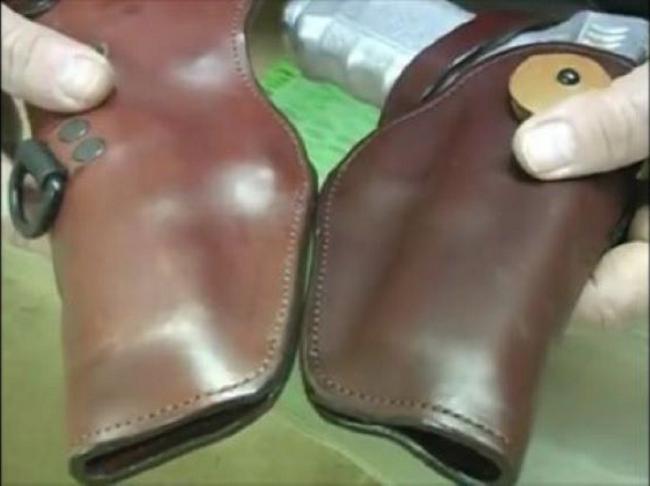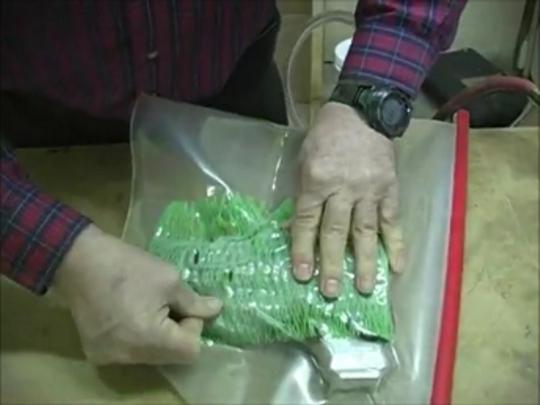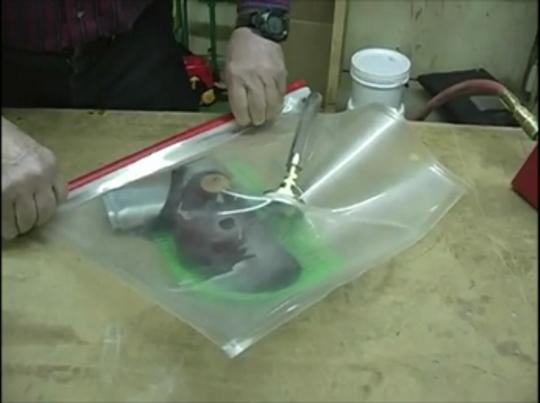
Vacuum Forming Leather with a Vacuum Press

Using a vacuum press to form leather offers precision, efficiency, and the ability to create intricate shapes that are difficult to achieve by traditional hand-forming methods. While this process is often associated with woodworking or composites, it has gained popularity in leatherworking for crafting high-end goods such as wallets, belts, armor, shoes, and molded cases. This article explores the advantages of vacuum forming leather, how to perform the process effectively, and the importance of using a breather mesh to ensure a complete evacuation of air during the vacuum press cycle.
What is Vacuum Forming in Leatherwork?
Vacuum forming involves placing damp or cased leather (leather saturated with water to make it pliable) into a mold or over a form and sealing it inside a
vacuum bag. A vacuum press extracts the air from the bag, forcing the leather tightly against the mold.
As the leather dries within this tight configuration, it retains the precise shape of the mold, producing sharp edges and intricate contours.
This process ensures consistency and allows leatherworkers to produce high-quality pieces, whether for custom designs, complex curves, or high-volume production.
The Benefits of Using a Vacuum Press for Leather Forming

1. Precision Molding and Detailing
Vacuum pressing allows for extremely accurate molding, which is essential for creating structured leather products like cases, shoe uppers, or decorative panels.
Compared to hand-molding, vacuum forming ensures uniform pressure across the leather surface, resulting in more precise and consistent impressions.
For leatherworkers producing multiple identical items—such as holsters or armor—this method offers repeatability without compromising detail.
Intricate textures, sharp lines, or deep embossments become easier to achieve and replicate with vacuum forming.
2. Improved Efficiency and Speed
Using a vacuum press reduces the time needed to form leather into complex shapes. The vacuum quickly pulls the leather over the mold and keeps it securely in
place during the drying process. Traditional methods may require hours of manual shaping or clamping, but the vacuum press ensures tight contact with minimal
effort, making it ideal for high-volume production.
Additionally, since the leather is firmly compressed against the mold, the drying process tends to be more uniform and quicker, further enhancing production efficiency.
3. Reduced Waste and Minimized Errors
Inconsistent results during hand-molding can lead to material waste, especially when working with premium hides. Vacuum forming minimizes the margin for error by ensuring that the leather adheres perfectly to the mold every time. For professionals who rely on precision, such as those making bespoke leather accessories, the vacuum press reduces variability between pieces and ensures that fewer materials are wasted.
4. Greater Design Freedom
The vacuum press allows leatherworkers to experiment with complex designs and shapes that would otherwise be difficult to achieve. Leather can be stretched and shaped into intricate forms with deep curves, compound angles, or concave and convex surfaces. This makes it possible to produce elaborate projects, such as molded leather armor or curved belt sheaths, without the need for excessive stitching or reinforcement.
Key Components of Vacuum Forming Leather
Before discussing the process in detail, it’s important to understand the main components involved:
Leather – Vegetable-tanned leather is typically used since it is highly moldable when wet and hardens as it dries. Thicker leather (e.g., 6-8 oz.) is often preferred for
structured forms like cases or holsters.
Mold or Form – A mold or three-dimensional form gives the leather its desired shape. These molds can be made from wood, plastic, or metal, depending on the project.
Vacuum Press with Bag – The vacuum press creates the suction necessary to form the leather. A high-quality vacuum bag ensures a tight seal around the mold and leather.
Breather Mesh A breather mesh or breather fabric ensures that air is evacuated completely from the
vacuum bag, preventing trapped air pockets and ensuring even pressure distribution.
The Role of the Breather Mesh in Vacuum Forming Leather

Breather mesh is a critical but often overlooked component in the vacuum forming process. This fabric or mesh material sits between the vacuum bag and the leather (or mold) to facilitate the evacuation of air during the vacuum cycle. Without it, air pockets can form inside the bag, preventing the leather from molding tightly to the form and causing imperfections in the final product. Here’s how the breather mesh ensures optimal results:
Prevents Air Pockets When air is being sucked out of the vacuum bag, the bag material can sometimes cling to the leather or mold before the air is fully evacuated.
This creates small air pockets that prevent the leather from adhering tightly to the form. A breather mesh prevents the bag from sealing prematurely, allowing air to escape smoothly through the mesh channels.
Ensures Consistent Pressure Distribution The breather mesh helps maintain even pressure throughout the entire mold surface. This consistency ensures that the leather
makes full contact with the mold at every point, capturing all the details and edges. Inconsistent pressure can result in wrinkling, uneven impressions, or areas that are not fully formed.
3. Improves Vacuum Efficiency By allowing air to escape more efficiently, the breather mesh shortens the vacuum cycle, ensuring the process is quicker and more effective.
This is particularly important when working with large pieces or thick leather, where complete evacuation might otherwise be challenging.
How to Vacuum Form Leather: Step-by-Step Process
Prepare the Leather Use vegetable-tanned leather, and soak it in warm water until it becomes soft and pliable. This is called “casing” the
leather. The leather should feel flexible but not mushy.
Set Up the Mold or Form Place the mold or form inside the vacuum bag. Ensure the mold is clean and smooth to prevent unwanted impressions on the leather.
Apply the Leather Stretch the wet leather over the mold, ensuring there are no creases or folds. Use clips or temporary adhesive to hold the leather in place if needed.
Place the Breather Mesh Lay a piece of breather mesh over the leather or wrap it around the mold. Make sure it covers the entire surface area to facilitate air evacuation evenly.

Seal the Vacuum Bag Place the mold and leather assembly inside the vacuum bag and seal the bag tightly. Check for leaks to ensure a proper vacuum.
Activate the Vacuum Press Turn on the vacuum press and allow it to run until the bag compresses the leather tightly around the mold. Make sure no
air pockets remain by observing the bag's behavior during evacuation.
Remove the Molded Leather Once the leather is dry, carefully remove it from the mold. Trim any excess leather and finish the piece by dyeing, burnishing, or sealing as desired.
Conclusion
Using a vacuum press to form leather is a game-changer for leatherworkers looking to enhance precision, efficiency, and creativity in their projects. The method reduces errors, improves
consistency, and allows for complex shapes that are difficult to achieve by hand. One of the most critical aspects of this process is the proper use of a breather mesh, which
ensures full evacuation of air and even pressure distribution throughout the mold. By following the right techniques and using quality materials, leatherworkers can achieve
professional-grade results with their vacuum-formed pieces.
Whether you are crafting high-end accessories or experimenting with intricate designs, vacuum forming leather is a valuable technique that can elevate the quality of your work.
Here is a link to a short video on using a vacuum press to form a leather holster Vacuum forming leather holster video.








